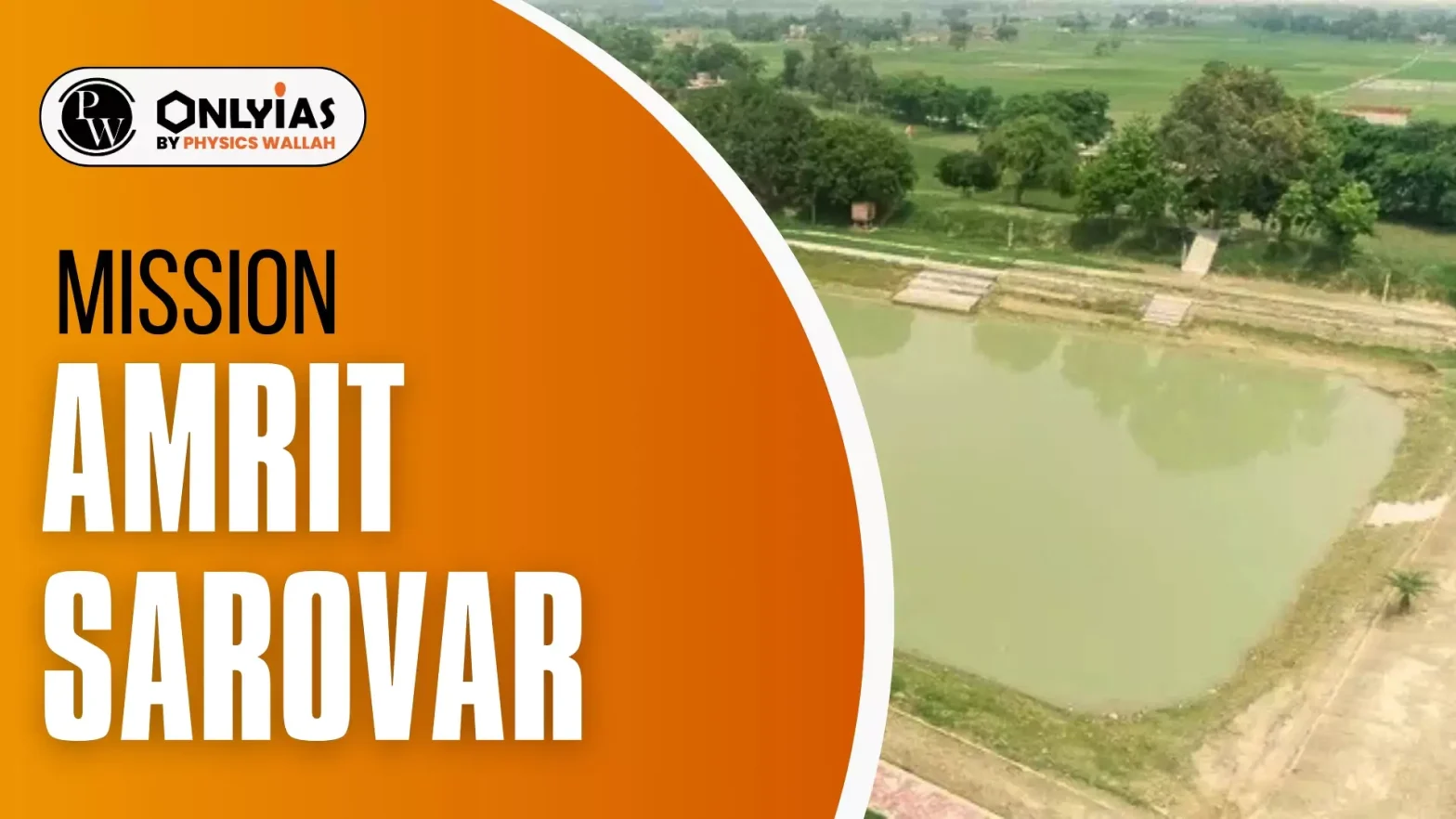Mission Amrit Sarovar was launched on 24th April 2022 to develop 50,000 ponds across India. Mission Amrit Sarovar contributes to water conservation, ecological balance, and sustainable livelihoods.

Mission Amrit Sarovar is a significant initiative launched by the Government of India to rejuvenate and develop water bodies across the country. Launched on 24th April 2022, this initiative aimed at rejuvenating and constructing 75 Amrit Sarovars in each district, totalling about 50,000 Amrit Sarovars across the country. The mission aligns with the broader objectives of Azadi Ka Amrit Mahotsav, celebrating 75 years of India’s independence. With water scarcity becoming a growing concern, Mission Amrit Sarovar aims to ensure long-term water sustainability.
| Mission Amrit Sarovar Overview | |
| Parameter | Details |
| Mission Name | Mission Amrit Sarovar |
| Launch Date | 24th April 2022 |
| Objective | Development and rejuvenation of 75 water bodies in each district |
| Total Target | 50,000 Amrit Sarovars across India |
| Ministry Involved |
|
| Technical Partner | Bhaskaracharya National Institute for Space Applications and Geo-informatics (BISAG-N) |
| Funding Sources |
|
| Minimum Pondage Area | 1 Acre |
| Minimum Water Holding Capacity | 10,000 cubic meters |
| Major Benefits |
|
| Completion Target | 15th August 2023 (Successfully achieved) |
| Key States Leading in Completion | Uttar Pradesh, Madhya Pradesh, Karnataka, Maharashtra, Rajasthan |
| Significance | Reviving traditional water bodies, reducing water scarcity, promoting sustainable water use |
Mission Amrit Sarovar is a water conservation initiative that seeks to construct and rejuvenate ponds (Amrit Sarovar) in rural areas to ensure water availability for future generations. The mission was designed to address the water crisis in rural areas while promoting community participation in water conservation efforts.
Launched on 24th April 2022 developed and rejuvenated 75 Amrit Sarovars (ponds) in each district of India. This results in the creation of around 50,000 water bodies across India.
The primary goal of this mission is to conserve water for the future while also supporting livelihood activities like fisheries, irrigation, and eco-tourism. The project follows a “Whole of Government” approach, integrating various ministries and government departments to achieve its objectives.
The primary objective of Mission Amrit Sarovar is to construct or rejuvenate at least 75 Amrit Sarovars in each district of India, ensuring a sustainable water source for communities. The key objectives of the mission include:
The Mission Amrit Sarovar was officially launched on 24th April 2022 and was successfully completed on 15th August 2023. The initiative was implemented as a part of Azadi Ka Amrit Mahotsav, focusing on developing sustainable water conservation structures in every district of the country.
Mission Amrit Sarovar was considered an ambitious project that was successfully completed within the planned timeline, demonstrating the government’s commitment to environmental conservation and sustainability.
The Mission Amrit Sarovar follows a “Whole of Government” approach, involving multiple ministries and organizations for effective implementation. The mission is primarily under the Ministry of Rural Development but includes participation from:
Additionally, the Bhaskaracharya National Institute for Space Applications and Geo-informatics (BISAG-N) is engaged as a technical partner to use geospatial data for identifying suitable locations for water bodies.
Mission Amrit Sarovar was designed to be systematic and sustainable, ensuring long-term benefits. The initiative incorporates modern techniques alongside traditional wisdom to maximize efficiency.
Mission Amrit Sarovar has successfully created and revived thousands of water bodies across India, addressing the water crisis in rural areas. The impact of the initiative is evident in the increase in water storage capacity and improved groundwater recharge.
As of November 28, 2023, the details of Amrit Sarovar’s works initiated and completed are as follows:
The mission not only achieved its initial goal of 50,000 water bodies but also surpassed it through efficient execution and widespread participation.
The State/UT-wise details of Amrit Sarovar that have been constructed or rejuvenated under the Mission so far are provided below:
| Sr. No. | State/ UT | Total number of Amrit Sarovar constructed or rejuvenated |
| 1. | Andhra Pradesh | 2,154 |
| 2. | Arunachal Pradesh | 772 |
| 3. | Assam | 2,966 |
| 4. | Bihar | 2,613 |
| 5. | Chhattisgarh | 2,902 |
| 6. | Goa | 159 |
| 7. | Gujarat | 2,650 |
| 8. | Haryana | 2,120 |
| 9. | Himachal Pradesh | 1,691 |
| 10. | Jammu And Kashmir | 1,056 |
| 11. | Jharkhand | 2,050 |
| 12. | Karnataka | 4,056 |
| 13. | Kerala | 866 |
| 14. | Madhya Pradesh | 5,820 |
| 15. | Maharashtra | 3,055 |
| 16. | Manipur | 1,228 |
| 17. | Meghalaya | 707 |
| 18. | Mizoram | 1,031 |
| 19. | Nagaland | 256 |
| 20. | Odisha | 2,367 |
| 21. | Punjab | 1,450 |
| 22. | Rajasthan | 3,138 |
| 23. | Sikkim | 199 |
| 24. | Tamil Nadu | 2,488 |
| 25. | Telangana | 1,872 |
| 26. | Tripura | 682 |
| 27. | Uttarakhand | 1,322 |
| 28. | Uttar Pradesh | 16,630 |
| 29. | West Bengal | 25 |
| 30. | Andaman & Nicobar* | 228* |
| 31. | Dadra Nagar & Haveli, Daman & Diu | 58 |
| 32. | Ladakh | 100 |
| 33. | Puducherry | 152 |
| Total | 68,863 | |
The funding model for Mission Amrit Sarovar is unique as it does not rely on a separate financial allocation. Instead, it integrates existing schemes for efficient resource utilization.
The importance of Mission Amrit Sarovar goes beyond just creating water bodies. It has transformed the way India manages its water resources, ensuring long-term benefits for both people and the environment.
While the mission has achieved remarkable success, there is still a need for future improvements. Sustainable growth and technological integration will help in further enhancing water conservation efforts.
Mission Amrit Sarovar is a transformative initiative in India’s journey toward sustainable water management. The successful creation of 50,000+ water bodies has ensured that water resources remain secure for future generations. Through community participation and strategic planning, the mission has laid the foundation for a self-reliant, water-secure India.
Mission Amrit Sarovar is a water conservation initiative aimed at developing/rejuvenating 75 ponds in each district of India to enhance water sustainability.
Mission Amrit Sarovar was launched on April 24, 2022, as part of Azadi Ka Amrit Mahotsav to boost water conservation across rural and urban areas.
The objectives of Mission Amrit Sarovar include water conservation, livelihood generation, and enhancing ecological sustainability through pond rejuvenation.
Mission Amrit Sarovar operates under multiple ministries, primarily the Ministry of Rural Development, Ministry of Jal Shakti, and Ministry of Panchayati Raj.
The mission aims to develop or rejuvenate 50,000 Amrit Sarovars across India, with each district constructing at least 75 ponds.
Mission Amrit Sarovar supports local communities by providing water for irrigation, fisheries, and other livelihood activities, ensuring sustainable development.
<div class="new-fform">
</div>
